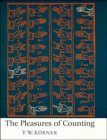'The Pleasures of Counting'

The Pleasures of Counting
by Tom Korner
Reviewed by Helen Joyce (Plus Editorial team)
"The pleasure and interest of being a scientist need not be confined to those gifted people who have the ability to pursue the highly specialised studies which are necessary for those who would reach the main frontiers of scientific advance."
G. I. Taylor, one of the great physicists of the twentieth century, among the last masters of both theory and experiment.
"The Pleasures of Counting" is all about the pleasure and interest of being a mathematician, and the book amply proves that these joys are accessible to anyone sufficiently interested, rather than just the elite few. The title is deceptively modest for such a wide-ranging book. And yet it is not inaccurate, since Tom Korner shows us how much can be done with relatively simple mathematics - including counting! - to solve real-life problems. Korner makes no attempt to hide himself behind the role of author - his personality shines through on every page.
This book is unusual in being both about and of mathematics. It could be read in many different ways. You could dip in and out, or just read the text, skipping the theorems and problems, or use it as a source for project topics.
The first section "The Uses of Abstraction" focuses explicitly on the part most mathematics books leave out - the bit where the mathematician turns the problem from something real-world to something abstract and hence attackable. Starting from the problem and then searching for a method of attack is central to mathematics research, but all too often mathematics is presented in just the opposite way in mathematics courses and textbooks. Anyone who wants to gain insight into what research actually involves and why one might choose to do it, need look no further than this book.
Some of the examples are entertainingly off-centre. For example, fractals are introduced via a theory of war which tries to link the length of the boundary between two nations to the probability that they will go to war. Turing's proof that there is no terminating algorithm to check whether any other algorithm terminates is introduced via the disastrous attempt in 1992 to computerise the dispatch of the London Ambulance Service. Refreshingly, rather than following the crowd and justifying the Poisson and Exponential distributions by considering the lifetimes an failure rates of lightbulbs, Korner shows how they arose in maintenance scheduling during the second world war.
There is considerable biographical material on some mathematicians whose work solved "real-life" problems, many of them involved in war efforts. Although quite a few of the topics are drawn from the First and Second World Wars, the book is no Boy's Own romp through war (this reviewer loathes military memoirs and so can be trusted on this!). The section on Enigma is fascinating, but even more impressive is the way in which very simple mathematics was used to startling effect in the First World War. For example, knowledge of averages and Cartesian coordinates enabled British bombers to improve their strike rate when "hunting" submarines by 50 percent, and an understanding of the difference in scaling between the area and perimeter of two-dimensional shapes allowed the British Navy to optimise the size of convoys, saving the lives of many thousands of merchant seamen and sailors.
Too often, it can seem that to solve a problem one needs to know the most esoteric and recent mathematics. Of course this is sometimes true, but this book hearteningly describes many occasions when understanding and the right approach to applying simple principles made enormous real-world differences.
- Book details:
- The Pleasures of Counting
- Tom Korner
- paperback - 544 pages (1996)
- Cambridge University Press
- ISBN: 0521568234